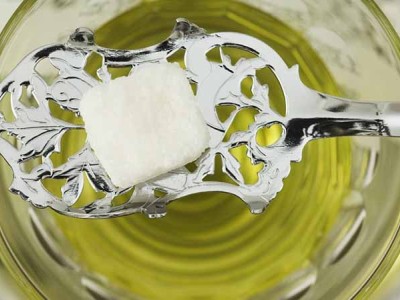35 Answers to the Most Frequently Asked Absinthe Questions - Everything You Wanted to Know About Absinthe
Whether you're a curious beginner or a seasoned connoisseur, this comprehensive guide is your ultimate companion in understanding the history, production, and consumption of absinthe. With expert insights and detailed explanations, it demystifies the myths and misconceptions surrounding this enigmatic drink, providing you with all the knowledge you need to appreciate absinthe's unique allure. Get ready to embark on a journey through the fascinating world of absinthe as we answer your most burning questions and shed light on its intriguing past and present.
Our comprehensive absinthe guide covers a wide variety of topics, from the preparation and consumption of absinthe to its history, effects, and legality. It's important to note that while absinthe has a fascinating history and unique qualities, like all alcoholic beverages, it should be enjoyed responsibly. So grab a glass, sit back, and let's explore the world of absinthe together!
1. Can absinthe cause seizures?
2. Can absinthe go bad?
3. Can absinthe impair vision?
4. Can absinthe lead to cognitive troubles?
5. Can absinthe make you hallucinate?
6. Can you drink absinthe straight?
7. How did absinthe become associated with bohemian culture?
8. How do you mix absinthe?
9. How do you properly serve absinthe?
10. How is absinthe made?
11. How should absinthe be stored?
12. Is absinthe addictive?
13. Is absinthe legal?
14. Is absinthe stronger than vodka?
15. Is there a non-alcoholic version of absinthe?
16. Is thujone dangerous?
17. Was absinthe really favored by artists and writers?
18. What are the effects of drinking absinthe?
19. What cocktails can you make with absinthe?
20. What does absinthe taste like?
21. What is absinthe?
22. What is in absinthe?
23. What is the "green fairy"?
24. What is the alcohol content in absinthe?
25. What is the best brand of absinthe?
26. What is the traditional absinthe ritual?
27. What is wormwood and why is it used in absinthe?
28. What's the difference between green and red absinthe?
29. Where can I buy absinthe?
30. Why do people put sugar in absinthe?
31. Why is absinthe green?
32. Why is absinthe sometimes referred to as a drug?
33. Why is water added to absinthe?
34. Why was absinthe illegal?
35. Why was absinthe so popular in the 19th century?
1. Can absinthe cause seizures?
There's no scientific evidence to suggest that absinthe causes seizures. Excessive alcohol consumption in general, however, can lead to a variety of health issues, including seizures.
2. Can absinthe go bad?
If stored correctly, absinthe should not go bad. However, it can lose its flavor and color over time.
3. Can absinthe impair vision?
No, absinthe does not impair vision. This is a myth stemming from the drink's early history.
4. Can absinthe lead to cognitive troubles?
There's no evidence that absinthe leads to cognitive troubles. However, absinthe is a very strong alcohol and excessive alcohol consumption can have various negative effects on cognition and overall health.
5. Can absinthe make you hallucinate?
The hallucinogenic properties of absinthe are certainly not a myth. While it contains thujone, which can cause hallucinations in large doses, the amount in some modern absinthes is minimal. If you, however drink absinthe with high levels of thujone, you should prepare yourself for surreal experience.
6. Can you drink absinthe straight?
You really shouldn't. Due to its high proof, absinthe is typically diluted with water rather than drunk straight. If you consume absinthe straight, it can badly hurt your health and burn your taste buds. Drinking absinthe straight is not recommended due to the intense flavor and high alcohol content.
7. How did absinthe become associated with bohemian culture?
Absinthe became popular in late-nineteenth-century bohemian society, particularly among artists such as Picasso and Van Gogh, as well as writers such as Paul Verlaine, Oskar Wilde, and Ernest Hemingway, who enjoyed its distinct effects and ritualistic preparation.
8. How do you mix absinthe?
Absinthe is traditionally mixed with cold water and sugar, but it can also be used in a variety of absinthe cocktails.
9. How do you properly serve absinthe?
Traditional absinthe service involves placing a sugar cube on a specially designed spoon, over a glass containing a shot of absinthe. Cold water is then slowly dripped onto the sugar cube, which dissolves and drips into the absinthe, causing it to louche, or turn cloudy, as the essential oils precipitate out of the solution.
10. How is absinthe made?
Absinthe is made by macerating herbs such as wormwood, anise, and fennel in high-proof alcohol and then distilling the mixture. The result is a clear, highly alcoholic liquid. Some absinthes are then subjected to a secondary maceration with additional herbs to achieve a green color and more complex flavor.
11. How should absinthe be stored?
As with all distilled spirits, store at 55-60°F / 13-16°C, somewhat cooler than room temperature. As long as the room temperature is not extremely hot, it is acceptable. When the bottle is just one-third full, decant it into a smaller container or drink it immediately to avoid oxidation and preserve flavor.
Avoid direct sunlight, which can destroy the aromatic ingredients in absinthe, and store it upright to avoid cork deterioration.
12. Is absinthe addictive?
Absinthe itself isn't addictive, but like any alcoholic beverage, it can lead to alcohol dependency if consumed excessively.
13. Is absinthe legal?
The legality of absinthe varies from country to country. In many countries, including the United States and much of Europe, absinthe is legal to produce, sell, and consume. However, there are often regulations concerning the amount of thujone (a compound found in wormwood) that it can contain.
In the United States, absinthe must be thujone-free. The FDA requires that the maximum thujone level in absinthe be less than 10mg, which is officially thujone-free. This means that all American absinthes including absinthe sold lawfully in the United States are bottled without wormwood. As wormwood is the most significant ingredient in absinthe, they cannot be regarded as true absinthes.
14. Is absinthe stronger than vodka?
In terms of alcohol content, absinthe is usually much stronger than vodka.
15. Is there a non-alcoholic version of absinthe?
There are non-alcoholic absinthe substitutes available, but they lack the unique characteristics provided by the alcohol and botanicals in traditional absinthe.
16. Is thujone dangerous?
Thujone, in large quantities, can be neurotoxic and cause hallucinations. However, the levels of thujone found in modern, legally-produced absinthe (especially those available in the US market) are far too low to cause such effects.
17. Was absinthe really favored by artists and writers?
Yes, absinthe was particularly popular among artists and writers in the late 19th and early 20th centuries. Many famous figures from this time, including Vincent Van Gogh, Oscar Wilde, and Ernest Hemingway, were known to be fond of the drink.
18. What are the effects of drinking absinthe?
As a high-proof spirit, the primary effect of drinking absinthe is intoxication, similar to other alcoholic beverages. Genuine absinthe with high level of thujone may have an unique psychoactive effects.
19. What cocktails can you make with absinthe?
Absinthe can be used in numerous cocktails, such as the Sazerac, Corpse Reviver #2, and the Chrysanthemum. See our list of absinthe cocktails for more inspiration.
20. What does absinthe taste like?
Absinthe has a complex flavor, characterized by strong notes of anise (which tastes similar to licorice), a distinct bitterness from the wormwood, and often a fresh, herbal character from the various other botanicals used in its production.
21. What is absinthe?
Absinthe is a distilled, highly alcoholic beverage. It is an anise-flavored spirit derived from botanicals, including the flowers and leaves of Artemisia absinthium ("grand wormwood"), along with green anise, sweet fennel, and other medicinal and culinary herbs.
22. What is in absinthe?
The primary ingredients in absinthe are wormwood, anise, and fennel. These herbs give absinthe its unique flavor profile and high alcohol content. Other botanicals may also be included depending on the specific recipe.
23. What is the "green fairy"?
The "Green Fairy" is an English translation of "La Fée Verte", a nickname for absinthe that originated in France. It refers to the traditional green color of the spirit and its association with bohemian culture.
24. What is the alcohol content in absinthe?
Absinthe typically has a high alcohol content, often between 45% and 75% of alcohol by volume (90 - 150 proof). This is significantly higher than most spirits, which are typically around 40% alcohol by volume.
25. What is the best brand of absinthe?
The "best" brand is subjective and depends on personal taste. Some popular brands include La Boheme Absinthe, Absinthe Ordinaire, and of course King of Spirits Gold Absinthe. This extraordinary green elixir boasts an impressive 100mg of the psychoactive thujone. Crafted with utmost care and adherence to an authentic recipe, this absinthe is composed of the most exquisite ingredients, rendering it a truly unparalleled sensory experience.
26. What is the traditional absinthe ritual?
The traditional absinthe ritual involves slowly dripping cold water over a sugar cube placed on a slotted absinthe spoon into a glass of absinthe.
27. What is wormwood and why is it used in absinthe?
Wormwood is a herb known for its bitter flavor, medicinal properties, and it is one of the primary ingredients in absinthe. While wormwood has a long history of medicinal use and was historically associated with witchcraft, its primary purpose in absinthe is to contribute to its unique taste.While it has a long history of medicinal use and was historically associated with witchcraft, its primary purpose in absinthe is to contribute to its unique taste.
28. What's the difference between green and red absinthe?
The color difference is due to the herbs used in the second steeping process. Green absinthe uses plants like hyssop and petite wormwood, while red absinthe uses hibiscus flowers.
29. Where can I buy absinthe?
Absinthe can be purchased at well-stocked liquor stores or online, depending on local laws and regulations. At Absinthe Original Liquor store, we take pride in offering the finest selection of genuine absinthe with thujone. We also provide a range of accessories to enhance your absinthe experience. Our collection includes exquisite replicas of absinthe fountains, absinthe spoons, and absinthe glasses. These accessories not only add to the authenticity of your absinthe ritual but also elevate the enjoyment of your favorite drink. Whether you're a seasoned absinthe connoisseur or a curious newcomer, our absinthe sets, complete with an elegant absinthe spoon, are the perfect choice for you.
30. Why do people put sugar in absinthe?
Sugar is used to balance the bitter notes of the wormwood in absinthe.
31. Why is absinthe green?
The traditional green color comes from the chlorophyll of the herbs used in the second, post-distillation maceration. This gives it the characteristic "verte" (green) color, and is the reason for one of its nicknames, "The Green Fairy".
32. Why is absinthe sometimes referred to as a drug?
This association likely comes from the misunderstanding and myth surrounding absinthe's hallucinogenic properties. In reality, while absinthe is a strong alcoholic beverage, it does not have any drug-like effects.
33. Why is water added to absinthe?
Water is added to absinthe to dilute it and to bring out its complex flavors, a process known as "louching".
34. Why was absinthe illegal?
Absinthe was believed to be addictive and associated with a range of detrimental health effects, largely due to the presence of thujone. It was banned in many parts of the world in the early 20th century, though these bans have mostly been lifted today.
35. Why was absinthe so popular in the 19th century?
Absinthe became popular due to its association with bohemian culture, its unique flavor, and the social ritual involved in its consumption.






